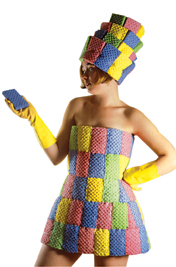|
ART EXHIBIT AT WILLIAM PATERSON UNIVERSITY
FOCUSES ON WEARABLE AND UNWEARABLE ART
 |
Where does one draw the line between what
can – or can’t – be worn on the human body? That
question is the focus of a new exhibit, “Crossing the Line:
Wearable to Unwearable,” on view at William Paterson University’s
Ben Shahn Galleries from March 22 through April 16. Gallery hours
are Monday through Friday, 10 a.m. to 5 p.m. Admission is free.
A closing reception for the exhibit will be held on Wednesday, April
14 from 4 to 5:30 p.m.
Curated by Nisha Drinkard, an assistant professor of art at William
Paterson, the exhibit features works by seven artists whose art
crosses the line between high art and functional design. “All
of these artists deal with the relationship of clothing to the human
body,” explains Drinkard. “Some create art that is unwearable
but rooted in the symbolism of decorating the body; others make
work that can be worn, but is perhaps not functional. It is really
for the viewer to decide where that boundary is.”
Kate Cusack uses everyday household objects to fashion her works.
Ordinary kitchen sponges in green, blue, yellow and pink, are sewn
together to make a wearable mini-dress, titled “Squeaky Clean,”
while coils of tin foil and wire are formed into a one-shouldered
shirt, also wearable, titled “Left Overs.”
Yonsenia White also creates wearable art, using commercially made
white men’s dress shirts to which she adds objects such as
safety pins or locks of blond hair. White, who describes herself
as an installation and performance artist, says her works examine
the “Eurocentric ideals of beauty, femininity and female sexuality
that fuel mainstream constructs of identity and desire.”
Childhood myths and adult anxieties about her body provide the inspiration
for Erica Spitzer Rasmussen’s work. “I use clothing
as subject matter because it allows me a ground on which to investigate
identity and corporeality. My garments are metaphors,” she
says. In addition to handmade paper, she incorporates non-archival
media such as spent tea bags or dried fish skins into her work,
transforming the work into something very personal. For example,
the back of her work “Coat of Talis” is adorned with
braids of hair from various mothers – a tradition followed
by mothers in Uzbekistan, who attach their braids to their children’s
coats as a talismanic means of protection.
Caroline Gibson addresses issues of clothes and personal appearance
in her sculptural works. “Life is an affair of putting on
and taking off clothes. It is an ordinary everyday task,”
she says. Gibson uses materials from everyday life –- tarpaper,
window screen, roof flashing, and more –- giving them a new
life in her work. Her work “Shoes” is fashioned from
gutter guard, leather and wax; “Foundation Garment”
is constructed of gutter guard, aluminum flashing, chrome risers
and copper wire.
In “Naked as Paper: A Victorian Wedding Gown,” Kathy
Bruce exhibits a performance piece. Based on “The Applicant,”
a poem by Sylvia Plath in which a woman is overqualified for her
domestic position, yet disposable, the dress is made of paper. On
display, it shows one view; in performance, it opens to reveal the
poem hidden inside her corset. “The wedding dress appears
as a superficial romantic illusion but one that in fact harbors
the reality of dark undertones…a traditionally precious object
presented as a throw away item,” Bruce says.
Maryann Riker creates books that are wearable bracelets and belts.
In “Chokeher,” a fabric-covered box embellished with
flowers opens to reveal a bracelet of paper. Heather Sincavage explores
the question of identity and the struggle from “female”
to just simply “individual” or “self” in
her work “Union,” constructed of two found beds, vellum,
cotton, rose petals and silver.
Drinkard joined the William Paterson art faculty in 2001, and teaches
courses in textile design. Her works have been exhibited throughout
the United States, and she has curated several shows at The Gallery
Space at Grace Church Van Vorst in Jersey City. A graduate of the
University of North Carolina at Charlotte, she earned a master of
fine arts degree from Arizona State University. She is a resident
of Teaneck.The exhibit is one of two shows on view concurrently
in the Ben Shahn Galleries. On view in the East and South Galleries
is “American Art Quilts,” featuring works by 35 artists
from across the country.
All exhibits are free and open to the public and are wheelchair
accessible. This exhibit is made possible in part by funds from
the New Jersey State Council on the Arts/Department of State, a
partner agency of the National Endowment for the Arts.
For additional information, please call the Ben Shahn Galleries
at William Paterson University at 973-720-2654.
- For
Further Information, contact:
- Mary
Beth Zeman, Director, Public Relations 973-720-2966
3/15/04
|
|







